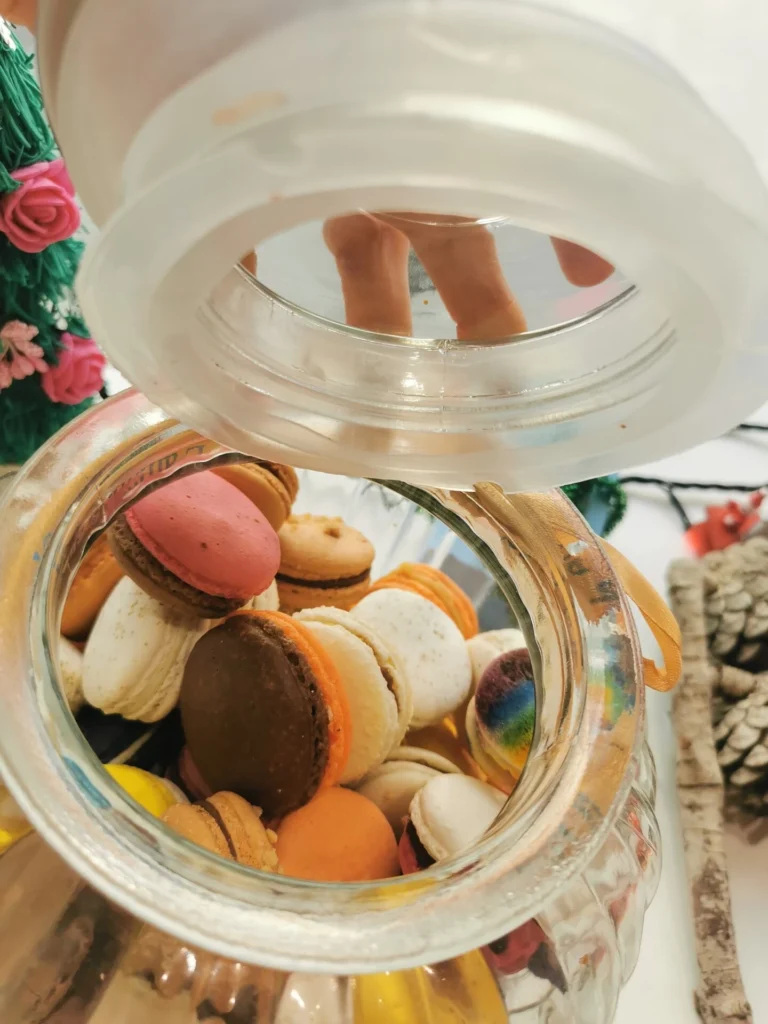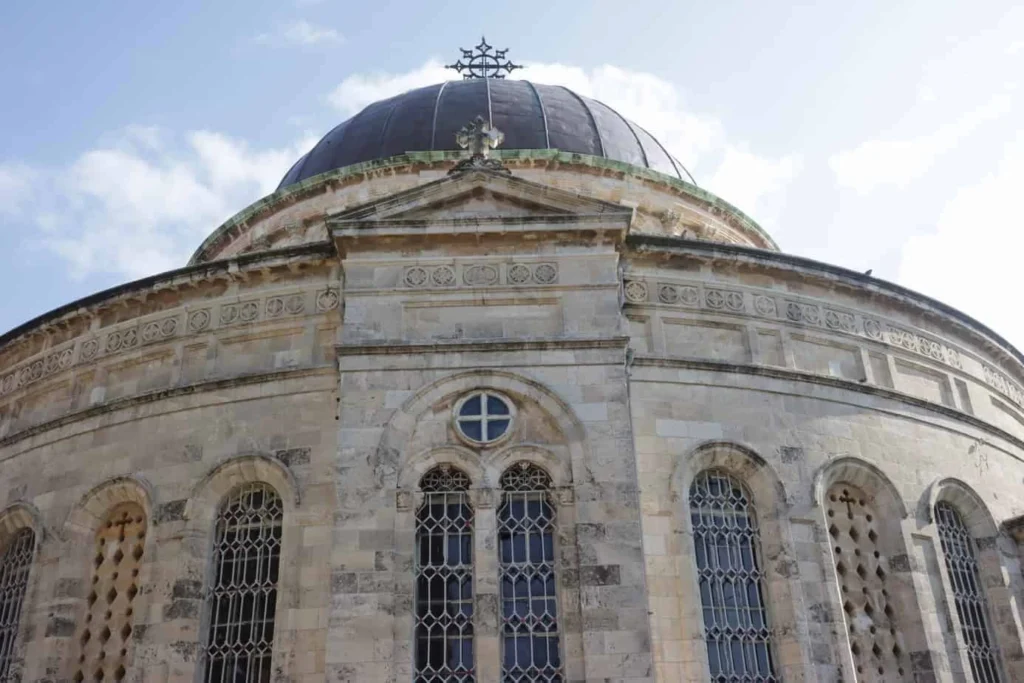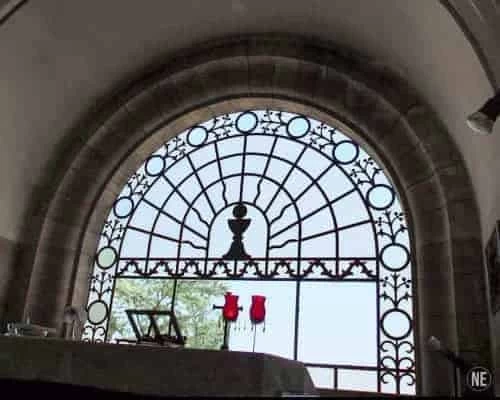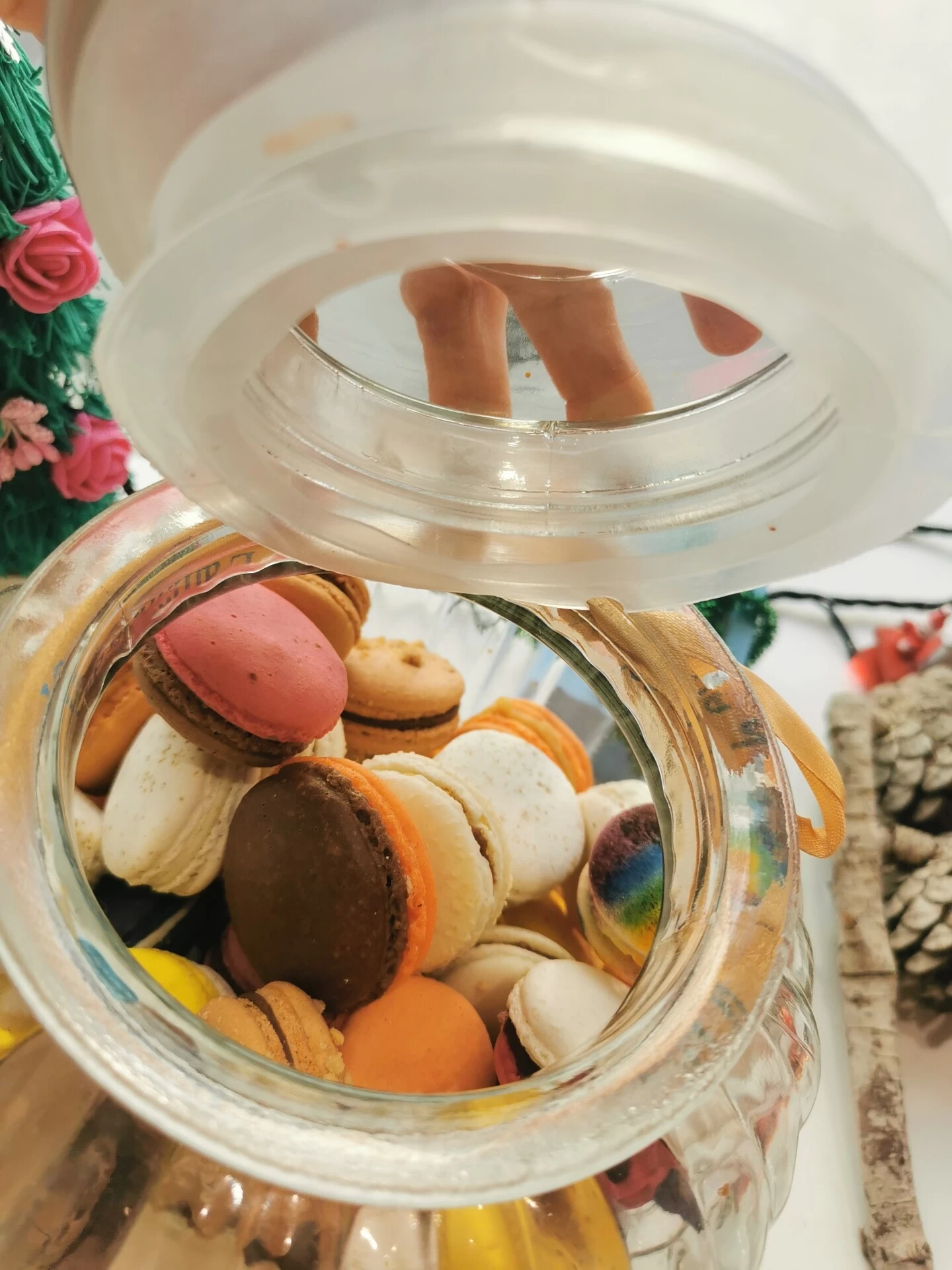Welcome to Machane Yehuda Market, the heart of Jerusalem! Situated centrally and conveniently close to the LRT station, this bustling market draws in locals, Israelis from all corners of the country, and curious travelers alike. It’s more than just a marketplace—it’s a vibrant community where vendors share a camaraderie, making it a warm and welcoming place to explore.
Join me on a virtual food tour through Machane Yehuda! Get ready to experience a kaleidoscope of flavors, colors, and scents that will tantalize your senses. Whether you’re in the mood for traditional Middle Eastern delicacies, international fare, or artisanal treats, Machane Yehuda has it all. So, are you ready to embark on a culinary adventure? Let’s dive in and savor the culinary delights of Machane Yehuda Market!
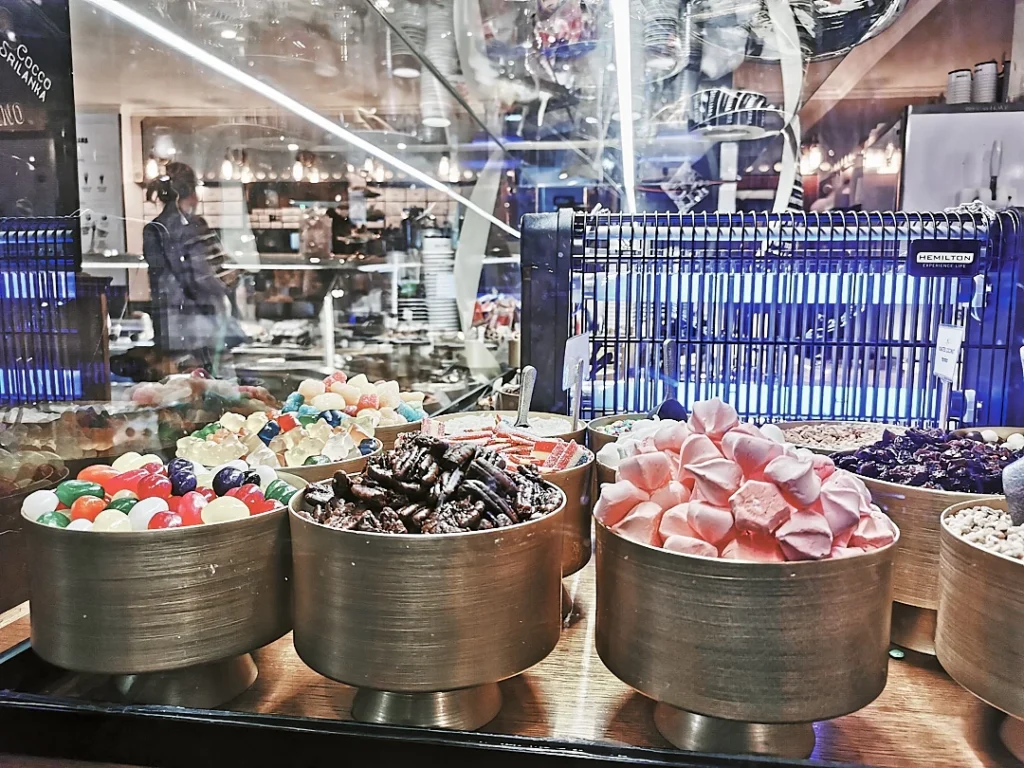
Kyortush- Imagine you are in Hungary
This traditional Hungarian pastry is known as Kürtőskalács (Kyortush), also called chimney cake. It’s characterized by its distinctive cylindrical shape, typically measuring 25 to 30 centimeters long with a hole in the center. One of the popular toppings for Kürtőskalács is a delicious combination of chocolate and cinnamon.
What sets Kürtőskalács apart from other pastries like Corason is its unique texture, thanks to the hole in the middle, which makes it lighter and fluffier. You can find Kürtőskalács in markets, where it’s often freshly baked and served hot from the oven. Alternatively, you can get it as a takeaway treat to enjoy later.
If you save it for later, store it in a cool area to preserve its delightful taste and texture. Whether enjoyed immediately or saved for later, Kürtőskalács promises a delightful taste of Hungarian culinary tradition!
Knafe-Soft oranges colors.
Knafeh is a traditional Arabic dessert crafted from semolina and goat cheese, topped with a sweet sugar syrup for an extra indulgent touch. In some variations, the topping is made from shredded kadaif noodles mixed with margarine or butter, along with palm oil, resulting in a vibrant orange hue (often enhanced with food coloring). To elevate the flavor profile, it’s typically garnished with fresh pistachio pieces, adding a delightful sweet-salty contrast.
The combination of warm, gooey cheese nestled within the crisp texture of the semolina creates a truly unforgettable taste sensation, making Knafeh a beloved treat in Arabic cuisine.
Halva, sweets to my sweet!
Halva, known for its delectable sweetness, is a beloved dessert enjoyed worldwide, with variations found in countries like India and Morocco. In Arabic, “halva” simply means “sweet,” a fitting name for this indulgent treat that tantalizes the taste buds. In Israel, vendors are generous with free taste samples, so don’t hesitate to try before you buy!
Made primarily from sesame seed paste (similar to tahini) and sugar, halva comes in a diverse range of flavors, including chocolate, coffee, vanilla, pistachio, and even banana. For the adventurous palate, there’s even whiskey-flavored halva!
One of the hallmarks of halva is its delightful texture, which melts in the mouth, spreading joy with every bite. Its long shelf life at room temperature adds to its appeal, making it a convenient and delicious treat to enjoy anytime.
For an extra touch of indulgence, halva is often adorned with pieces of pistachio, adding both visual appeal and a delightful crunch.
In the bustling Machne Yehuda market, you’ll find not one, but two stores dedicated to halva, both boasting large machines that produce tahini using traditional millstones. Look for “The Halva Kingdom” sign to discover these sweet havens amidst the market’s vibrant offerings.
Olives- Ancient love
Olives hold a rich history and significance in the land of Israel, dating back to ancient times. Utilized for various purposes such as fuel, cosmetics, and ceremonial practices, including funeral rites and anointing kings, olives have long been cherished by the local people.
These versatile fruits come in three main varieties: those intended for eating, those meant for oil extraction, and types suitable for both purposes.
While the olive trees in the courtyard of Gethsemane Church at the foot of the Mount of Olives in Jerusalem are often touted as among the oldest in the world, estimated at over 1500 years, experts argue that their age likely does not exceed 500 years, debunking this urban legend.
Olive oil is highly regarded for its health benefits, particularly when produced through cold pressing methods, preserving essential components such as oleic acid and vital vitamins.
Evidence of olive oil’s historical use abounds in Israel, with well-preserved ancient oil mills found in places like Beit Guvrin National Park.
In modern-day Israel, olives are beloved in all their forms. While local production satisfies some of the demand, imports from countries like Greece (known for Kalamata olives) and Spain (famous for Manzanillo olives) supplement the supply. The Western Galilee region boasts main olive fields, and boutique shops, such as the local “Parag” store, offer artisanal olive oil products, often accompanied by educational materials and documentaries celebrating the rich tradition of olives in Israel.
Drinks- Vitamin C Station
At Eli Uzi’s renowned juice shop, you’ll discover a delightful array of fruit-based concoctions to tantalize your taste buds. From refreshing watermelon and tangy cherry to succulent melon and beyond, there’s a juice flavor to suit every preference. But the offerings don’t stop there—this vibrant establishment also features a selection of cosmetic products infused with the essence of fruits, embracing their natural goodness.
Among the diverse range of fruit juices available, the “promenade” stands out for its well-known health benefits, drawing patrons seeking a nutritious boost. For those craving classic flavors, you can’t go wrong with the timeless favorites of orange and carrot juice. Alternatively, venture into more adventurous territory with options like invigorating ginger and apple or the luscious blend of mango, banana, and dates—an undisputed favorite among regulars. Whether you’re in need of a revitalizing pick-me-up or simply seeking a delicious treat, Eli Uzi’s juice shop offers an abundance of fruity delights to indulge in.
Accessories -Home is where are heart is
You can also buy here hats and products for your home. Among the stores you could find here “dream keepers” store, local Jewelries stores and designer clothes shop (for example : Talia Boutique which sells clothes from Italy at Agrippa’s 109 street).
You can also find flower shops. Buying bouquets at home on weekends is customary to welcome the Shabbat with pretty flowers.
There are many more places that we did not mention: cheese shops, Bakeries, Fish, Meat, and so on. Well, we can not reveal all the secrets here, right? * We would love to answer any questions about the market and give you a personal recommendation. Please DM us.
As night falls, Machane Yehuda market undergoes a vibrant transformation, casting off its daytime hustle and bustle to embrace a lively nocturnal atmosphere. The streets come alive with the chatter and laughter of young revelers, drawn to the market’s array of watering holes and eateries. It’s a sight to behold as groups of friends gather to unwind over cold beers and delectable fare, immersing themselves in the pulsating energy of the night.
For a truly memorable experience, be sure to visit on Thursdays, when the market pulsates with an electric buzz as students flock to kickstart the weekend festivities. The air is filled with anticipation and excitement, creating an infectious energy that’s impossible to resist. Join in the revelry as you sample the eclectic culinary offerings and toast to the joy of good company amidst the vibrant tapestry of Machane Yehuda market by night.
Travel information
Entrance from the market is from Jaffa street or Agrippa’s street.
Market is open between: 8:00-19:00 every day, on Friday 8:00-15:00 and on Saturday its closed, but during the evening the pubs and bars are open.
Entering the market if from Agripas street or Jaffa street.
Arrival Using Local Transportation
The common way to arrive to the Machne Yehuda Market is to take the light train from the center bus station untill arriving to Jaffa Street entrance.
You can also take the following buses from the central bus station and stop at Agrippa’s Street:
Lines: 6,8,18,21,32,74 and 75.
opening hours
The Market is open all week long except for Saturday’s and holidays.
Sunday-Thursday open from 08:00 am until 19:00 pm.
Friday open on 08:00 until 15:00
Saturday: The market is closed. However, in the evening the coffee shops, restaurants and pubs are open.
The best time to visit is from 09:00 am until 17:00 afternoon.
Arrival options
| Bus | From the central bus station there are many bus lines which stops near the market entrance at Agripas street- : 6, 8, 18, 32, 21, 74, 75 |
| Light Rail Train | This is a cheap and convenient way to reach the market. You can take a light rail train directly to the market from the central bus station. In case you are using a car, can park your car free of charge in one of the lightest trail train stations at Herzel Mountain (הר הרצל) and Givaat Hatachmoshet (גבעת התחמושת). You should by transportation card called “Rav-Kav” and pay for 1.5 hours, daily or monthly use. That way you can easily combine between the bus lines and the light rail train using the same transportation card. |
| Car | Here are some parking options near Machane Yehuda market: Old Shari Tzedek parking lot (Shabat Tzedek street) – only a 5-minute walk away. The cost is 10 NIS per hour. On busy Fridays, you could get free 2 hours of parking with a receipt from the market for purchases totaling 100 NIS and above. Menorah parking lot (Zerar Bachar street) – located about a 10-minute walk from the market, offering a good rate of 6 NIS per hour. Fridays offer the first 2 hours free with a market receipt of 100 NIS and above. The Market parking lot at Agripas 88 streets – the rate is 20 NIS for the first hour, with an additional 5 NIS per every extra 15 minutes thereafter. The daily total rate is 70 NIS. Mamilla parking lot (located under Mamilla Mall at Itzhack Kariv 1 street) – accessible via the light rail train. The first hour is free, and from the second hour onwards, it’s 12 NIS per hour. Above 4 hours, the total daily rate is 48 NIS. |
| Taxi | Use a cab using “Get-Taxi app”. Local’s tip: if you see an empty taxi it might not stop for you as it has been booked ahead. |
| Walking | If the weather allows you can walk from the local bus station by foot on Jaffa street until you see the market entrance. |
Weather/clothing
Jerusalem is renowned for its cold winter weather, often characterized by what locals affectionately call “The Crazy Jerusalem Wind,” which seems to penetrate right to the bones. If you’re planning to visit the market during the winter season, it’s wise to bring along an umbrella and a sweater to stay warm and dry.
Interestingly, the market is partially covered by a rooftop structure, providing protection from the scorching summer sun and shielding visitors from the rain during the winter months. This makes it a comfortable and enjoyable destination to explore regardless of the weather conditions outside.
Toilet
You have here three free public and often cleaned toilets:one for men, another one for women, and the last one for both on Shizaf Street.
1] Women Toilet :on Etch Hayaheem street in the entrance to the market from Agripas steet
2] Men and Women Toilet on Shizaf steet .
3] Men Toilet on Hatapuach street.
Site explaining
Entering the Machne Yehuda market always evokes memories of my youth, when my grandmother would come here every week with her trusty “big basket on wheels,” filling it with fresh vegetables and fruits. I was always eager to discover what tasty surprises awaited me each time. The market symbolizes Israeli society, showcasing a diverse array of tastes from each local culture.
There are two entrances to the market: the main one is from Jaffa Street, directly across from the light railway station, and the other is on Agrippa Street.
The market itself consists of two parts: an outdoor section and an indoor area with a roof that provides protection from the sun.
As you enter through the main gate on Jaffa Street, you’ll be greeted by rows of stores on either side, bustling with activity. After a quick security check by the guards, you’ll be immersed in the lively atmosphere of vendors shouting and singing their wares.
Two main streets, “Etz Hachayim” Street and “Machne Yehuda” Street, run from Jaffa Street and back, intersected by smaller streets named after fruits. Additionally, there are two internal markets known as the Iraqi and Georgian markets.
For the adventurous foodie, I recommend exploring the variety of tastes available. Join me on a virtual tasting tour as we discover the culinary delights of Machne Yehuda market. Beteavon! (Bon Appetit/Enjoy your meal in Hebrew)
Why does it called Machne Yehudas, who is Yehuda?
Yosef Navon, a Jewish entrepreneur, played a pivotal role in the development of Jerusalem in the early 19th century. Alongside his partners, the wealthy banker Johannes Frutiger and businessman Shalom Konstrum, Navon spearheaded the construction of the railway from Jaffa to Jerusalem. To commemorate his contributions, a new neighborhood was established in the heart of Jerusalem, named after Navon’s elder brother, and thus came to be known as the “Machane Yehuda” neighborhood.
Subsequently, a local Jewish family acquired a sizable parking lot within this neighborhood, which soon transformed into a bustling marketplace where locals gathered to sell their goods. This vibrant market eventually became known as the “Shuk Machne Yehuda” (Shuk meaning market in Hebrew). Over the years, the shuk underwent various transformations, evolving from a modest outdoor market to a bustling hub of small stands and shops, eventually shaping into the vibrant marketplace it is today.
Throughout its history, the shuk witnessed significant changes, from the transition of power from the Ottoman Empire to the British Mandate, to the establishment of the State of Israel. In the early 21st century, the market underwent a major transformation, reflecting the dynamic spirit and cultural richness of Jerusalem.
Final word’s
The Machne Yehuda Market holds a special place in the hearts of Jerusalemites and visitors alike, ranking among the city’s most cherished attractions alongside iconic sites like the Western Wall, the Tower of David, and the Yad Vashem Museum.
It’s not just a market; it’s a vibrant meeting point where locals and travelers come together to indulge in delicious food and engage in heartfelt conversations. There’s an authenticity here that can’t be replicated elsewhere. For over 130 years, this market has stood as a testament to the spirit of Jerusalem, drawing people in with its unique charm and timeless appeal. Come and experience it for yourself—you won’t be disappointed.

